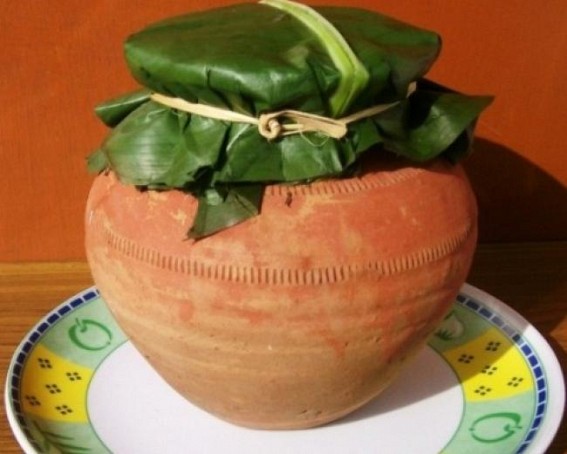Achintya Kumar Sinha & Dr. Sourabh Deb

PHOTO : Langi Picture courtsey : www.tripura.org.in
1. ABSTRACT
Tribal communities in Tripura, like elsewhere in northeast India, make their own beer and spirits. There generally is no taboo on consumption of alcoholic beverages by adults in tribal societies. This article describes some aspects of the herbal rice beer ‘Chuwak Bwtk’, briefly Chuwak, of Tripura known for its pleasant non-aggressive aroma and unique taste. Chuwak is popularly known amongst the non-tribal as Langi in the name of the small earthen pitcher wherein it is brewed and served. The write up includes documentation of ingredients used, processing and preparation of the yeast, brewing Langi; associated hygiene protocols as well as the way the brew is served and sipped. Langi is hugely popular amongst the local people both tribal and others; and it has a thriving market with hundreds of tribal women engazed in production and sale of the brew. The ‘illicit’ tag however leads to harassment and humiliation of processer-traders, all women, by the law enforcing personnel; and the civil society may deliberate on this sensitive issue for an out-of-the-box remedy. Appropriate government intervention with research inputs is crucial at this stage to promote Langi as a signature brand of Tripura, like Feni is for Goa.
2. INTRODUCTION
2.1 State: Tripura is the second smallest state next to Sikkim in the north eastern region of India; and its geographical area is 10491 km2. The terrain consists predominantly of hill ranges and undulating uplands, the plains being limited to 19.8 percent of the geographical area. About 60 percent of the area of the state (6292.681 sq. km) is government forest. The territory enjoys a typical monsoon climate with annual precipitation between 2250 mm to 2500 mm. The minimum and maximum temperatures during winter range from 40C to 330C; and during summer from 210C to 380C. With a population of 3,673,917 (Density-350 per square km), as per Census 2011, it is the second most populous state in the north-east next to Assam. The percentage of tribal population in Tripura varied from 50.09 to 54.69 percent between 1921 and 1941 Census (Bhatacharya, 1992) as against 31.1 percent as per Census 2011. There are as many as nineteen ethnic groups among the scheduled tribes, each having their distinctive language or dialect and cultural tradition. These are Tripuris, Reangs, Jamatias, Noatias, Chakmas, Halams, Mogs, Kukis, Garos, Lushais, Uchais, Mundas, Orangs, Santals, Khasias, Bhils, Chaimals, Bhutias and Lepchas. The two prominent languages used in Tripura are Bengali and Kokborok. The tribes belonging to the ‘Bodo’ branch of the Tibeto-Burmese family of languages in Tripura speak in Kokborok with certain variations in dialects (Murasingh, 2007); and these include the Tripuri, Reang, Jamatia and Uchai tribes. Kokborok is spoken by around 80 percent of tribal population in Tripura.
The economy is primarily agrarian with agriculture providing 60 percent of employment. Tribal communities depended in the past principally on shifting cultivation, known locally as jhum was a way life influencing their socio-cultural, folk literature and religious life. Jhum continues till date, but at a much lesser scale. A large majority has by now adopted alternative livelihood options like agriculture, horticulture, rubber plantations, animal husbandry etc. The National Forest Commission Report of 2006 cited 43000 households of shifting cultivators on the whole in Tripura covering an area of 22300 ha of forestland. 2007 survey of hardcore shifting cultivators by the state forest department reported 27286 households primarily dependent on jhum. Most of the tribal population also depend on non-timber forest products (NTFP) for edibles such as herbs. Tubers, flowers, mushroom, etc (Sharma, 2009) as well as non-edibles like bamboo, broom grass, cattle fodder, thatch grass, leaves of wild banana, etc from forests for own use as well as for sales with or without value addition. According to a survey in 2008 by NTFP Centre of Excellence at least 303 MT of edible NTFP was harvested for sale and 2250 MT for self consumption during the rainy season was worth INR 280.12 lakh (Sharma, 2009).
2.2 Herbal rice beer & tribal communities: Consumption of alcoholic drinks by adults is natural for tribal communities in Tripura barring a few exceptions. Use of alcoholic beverages ‘practically seized to exist’ amongst the Lushais following ‘spread of Christianity’ (Chakraborty, 2011). Some amongst the Tripuri and Reang tribes who take to Vaishnavism shun alcohol; but they constitute a very small minority. For the tribal communities in Tripura, alcoholic beverages are essential for all of their social and religious events. They brew their own herbal rice beer and also distil the stronger liquor. Langi is also an intermediate product in the process that culminates in the distilled varieties of the liquor, known in Tripuri as Chuwarak. Guests are served with homemade Chuwak, a safe and soothing drink, as a gesture of warm welcome. The Reangs, the second largest population of tribes next to Tripuris in the state, know Chuwak as ‘Cha’ (Gan Choudhuri, 2011), the Kaipengs, know it as Jokla (Bhattacharya, 2002) and the Chakmas as Jogara (Mazumdar, 1997). Lack of official recognition and resultant persecution by law enforcing personnel could not in any way wipe out or even diminish the production and consumption of these traditional beverages. This calls for an out-of-the-box for a remedy.
2.3 Methodology
Relevant literature was scanned for an overview of the subject matter of this study. Primary information on herbal rice beer of Tripura was derived through interaction with processer-traders, consumers as well as other individuals and organizations conversant with the subject during field visits. The paper is based on processing, in-depth analysis and interpretation based on inputs from the primary and secondary sources.
3. CHUWAN, THE YEAST FOR BREWING LANGI
3.1. Ingredients for Chuwan: Chuwan is the catalyst or yeast for brewing the popular herbal rice beer of Tripura known as Chuwak or Langi. It is a dry cake made of numerous plant/herbal products and of raw rice (not parboiled). A few plant ingredients used for preparation of Chuwan differ from community to community, and at times from locality to locality. Vernacular names of these plants have not been standardized with resultant confusion. The following table with some details of plants and plant ingredients required for producing Chuwan was assembled based on field visits, inspection and interaction with the Tripuri community in Khwmnlg, HQ of the Tripura Tribal Areas Autonomous District Council (TTAADC) and a knowledgeable TTAADC official of Tripuri tribe.
Table 3.1
Plant/herbal ingredients for Chuwan making
|
Sl. No. |
Name of the species |
Common name |
Requirement per kg of dry rice |
|
1 |
Erioglossum rubiginosum |
Chuwanti sikaam (KB) |
Bark & tender leaves from 3 branches |
|
2 |
Thunbergia grandiflora |
Duk mang khong |
5-6 leaves |
|
3 |
Oroxylum indicum |
Tokharung(KB)/ Kanai Dinga(B) |
3-4 leaves. Excess quantity will spoil the brew |
|
4 |
Markhamia stipulata |
Chuanchela (KB) |
5 leaves for improving taste |
|
5 |
Allophylus racemosus |
Chinrama (KB) |
10-15 leaflets & bark from 2-3 branches |
|
6 |
Engelhardia spicata |
Tokhiseleng (KB) |
10-11 leaflets and 1 surface root |
|
7 |
Artocarpus heterophyllus |
Jackfruit tree |
10 tender leaves |
|
8 |
Saccharum officinarum |
Sugarcane |
3 tender leaves |
|
9 |
Ananas comosus |
Pineapple |
3-4 tender leaves |
|
10 |
Capsicum annuum |
Red chilly |
3 |
|
11 |
Citrus reticulata |
Orange |
The exocarp of one fruit |
|
12 |
Holarrhena antidysenterica |
Kurcha (B) |
150-200 grams of bark |
PS: ‘KB’ for Kokborok and ‘B’ for Bengali ‘in the table above
3.2 Variation in choice of ingredients for Chuwan, an example: A thriving processer-trader of Chuwan from Anandanagar village of Mohanbhog Block in Sepahijala District of Tripura disapproves use of Tokharung, exocarp of orange and leaves of Jackfruit (Table 3.1). Exocarp of orange would, according to her, retard the brewing process for Langi. She also showed a twig of a climber Bwtk Blwi (Tricosanthes spp.), two leaves of which would be added per kg of rice as an ingredient for making Chuwan; and this species is not listed in Table 3.1. She reported further about a tree species known as Kalfu in Kokborok, the sweet and aromatic bark of which she had used in the past as one of the ingredients for preparing Chuwan for enhancing the flavour and taste of Langi. She informed further that the species was no longer available in her neighbourhood as natural forests had been replaced by plantations of commercial timber yielding species and rubber. Based on her description of the species, one specimen of Kalfu tree was located in nearby Jibandeep Joint Forest Management (Angshidari Banayan Prakalpa) project in Melaghar and that was identified as Cinnamomum obtusifoliaum. The authors requested the Centre for Forest-based Livelihoods & Extension (CFLE) for conservation and propagation of the tree species.

3.3 Collection of Plant Ingredients for Chuwan: Jackfruit, sugarcane, red chili and excocarp of orange in the list (Table 3.1) of ingredients are easily available from homestead gardens or nearby markets. The others in the list are gathered generally from natural forests. Due to large-scale conversion of natural areas into artificial plantations using a few commercially important species since mid-1970s coupled with extensive deforestation and degradation of forests, the stock of these naturally occurring species is generally on the decline. Chuwak processors have to devote considerably more time now in search of these plant ingredients, thus affecting profitability adversely. Some plant ingredients, leaf of Allophylus racemosus for example, can be used even when dry and processers prefer to collect and stock such plant products from forests and natural areas in advance after drying.
Full Article of 9 Pages available at the link below :
tripurainfoway.com/tempimg/file/HERBAL%20RICE%20BEER.pdf
Period of field study: 2013
Key words: Chuwak Bwtk, Feni, Langi, Herbal rice beer, Tripura
Authors:
Mr. Achintya Kumar Sinha, Former Chief Conservator of Forests, Agartala. Contact: achintyaksinha@gmail.com

Dr. Sourabh Deb, Assistant Professor, Department of Forestry and Biodiversity, Tripura University, Agartala
- Why Modi’s BJP swept key India regional elections
- TIWN’s landmark legal victory against BJP Govt’s Illegal attacks to shutdown fearless Media
- India to be world's third-largest economy by 2030 -S&P Global Ratings
- Tripura's Dark Era : Mafia style Brutal attacks on Journalists, fight for your Citizen rights !
- How to access tripurainfoway.com via HOLA from India




